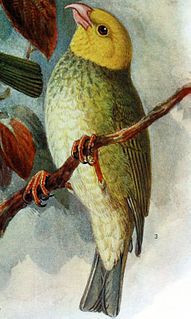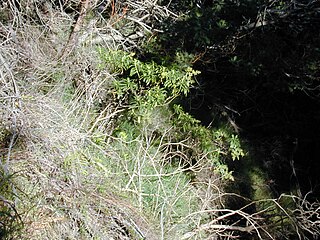
The ʻōʻū is a species of Hawaiian honeycreeper endemic to the Hawaiian islands. It has a dark green back and olive green underparts; males have a yellow head while females have a green head. Its unusual beak seems to be adapted to feeding on the fruits of Freycinetia arborea. It has a strong flight which it uses to fly considerable distances in search of this Hawaiian endemic vine, but will eat other fruits, buds, flowers and insects.

The Alakaʻi Wilderness Preserve, popularly known as Alakaʻi Swamp, is a montane wet forest on the Hawaiian island of Kauaʻi. Although the preserve is home to alpine bogs, it is not a true swamp. It is located on a plateau near Mount Waiʻaleʻale, one of the wettest spots on Earth. Due to its unique combination of high elevation and climate, the Alakaʻi Swamp harbors a large number of endangered endemic species that are only found in this area and whose population has been dramatically declining over the last decades. It is designated as a IUCN protected area.

Astelia waialealae is a rare species of plant in the Asteliaceae family that is endemic to the island of Kauaʻi of the state of Hawaii in United States. It inhabits montane bogs within the vicinity of the Alakaʻi Swamp on the island's central plateau. A. waialealae is threatened by habitat loss and habit disturbance by feral pigs; there are only about 26 plants remaining. It is a federally listed endangered species.
Labordia cyrtandrae, the Koʻolau Range labordia, is a species of flowering plant in the Loganiaceae family. It is endemic to lowland tropical moist forests in Hawaiʻi, and is threatened by habitat loss. Like other Labordia species, this plant is known as Kamakahala.
Psychotria hobdyi, the milolii kopiwai, Hobdy's wild-coffee or kopiko, is a species of plant in the family Rubiaceae. It is endemic to the Hawaiian Islands, where it is known only from the island of Kauai. There are about 10 populations for a total of about 120 individuals. It is threatened by habitat loss and was federally listed as an endangered species of the United States in 2010.

Ambrosia pumila is a rare species of herbaceous perennial plant known by the common names San Diego ragweed and San Diego ambrosia. It is native to far southern California, Baja California, and Baja California Sur. It grows in floodplains and open grasslands in proximity to wetland areas.
Cyrtandra oenobarba is a rare species of flowering plant in the African violet family known by the common name shaggystem cyrtandra. It is endemic to Hawaii, where it is known only from the island of Kauai. It can be found in only three localized areas of the island and there are fewer than 500 individuals remaining in the wild. It was federally listed as an endangered species in 2010. Like other Hawaiian Cyrtandra it is called ha`iwale.
Cyrtandra paliku is a rare species of flowering plant in the African violet family known by the common name cliffside cyrtandra. It is endemic to Hawaii, where it is known only from the island of Kauai. The plant was first discovered in 1993 and it was described to science as a new species in 2001. At the time it was discovered there was only one population containing 70 individuals; a 2006 count revealed only ten plants remaining. It was federally listed as an endangered species in 2010. Like other Hawaiian Cyrtandra it is called ha`iwale.
Cyanea rivularis is a rare species of flowering plant in the bellflower family known by the common name plateau cyanea. It is endemic to Hawaii, where it is known only from the island of Kauaʻi. There are three small populations of the plant remaining in the wild, for a total of 19 individual plants. The plant was federally listed as an endangered species of the United States in 1996.
Dubautia kalalauensis is a rare species of flowering plant in the family Asteraceae. It is endemic to Hawaii where it is known only from the island of Kauai. There is only a single known population composed of 26 plants. It was federally listed as an endangered species of the United States in 2010. Like other Dubautia this plant is known as na`ena`e.

Dubautia plantaginea is a rare species of flowering plant in the aster family known by the common name plantainleaf dubautia. It is endemic to Hawaii where it is the only member of the silversword alliance that is found on all six of the largest islands. Two of the three subspecies are rare and endangered. Like other Dubautia this plant is called na`ena`e.

Dubautia waialealae is a rare species of flowering plant in the family Asteraceae known by the common name Wai'ale'ale dubautia. Like other Dubautia this plant is called na`ena`e.
Exocarpos luteolus is a rare species of flowering plant in the sandalwood family known by the common names leafy ballart or heau. It is endemic to Hawaii, where it is known only from the island of Kauai. There are eight populations remaining, for a total global population of only 39 individuals. The plant was federally listed as an endangered species of the United States in 1994.
Geranium kauaiense is a rare species of geranium known by the common name Kauai geranium. It is endemic to Hawaii, where it is known only from the island of Kauai. It was federally listed as an endangered species in 2010. Like other Hawaiian geraniums, this plant is known as hinahina and nohoanu.
Labordia helleri, the Nā Pali coast labordia or Heller's labordia, is a rare species of flowering plant in the Loganiaceae family. It is endemic to Hawaii, where it is found only on Kauai. It is a federally listed endangered species of the United States. Like other Labordia species, this plant is known as Kamakahala.

Lysimachia daphnoides is a rare species of flowering plant in the Primulaceae known by several common names, including Pacific loosestrife, lehua makanoe, kolekole lehua, and kolokolo kuahiwi. It is endemic to Hawaii, where there are only three populations remaining on the island of Kauai. It was federally listed as an endangered species of the United States in 2010.
Phyllostegia wawrana is a rare species of flowering plant in the mint family known by the common name fuzzystem phyllostegia. It is endemic to Hawaii, where it is limited to the island of Kauai. It is a federally listed endangered species of the United States.
Poa mannii is a rare species of grass known by the common names Mann's bluegrass and Olokele Gulch bluegrass. It is endemic to Hawaii, where it is limited to the island of Kauai. It is threatened by the loss and modification of its habitat. It is a federally listed endangered species of the United States.
Schiedea apokremnos is a rare species of flowering plant in the family Caryophyllaceae known by the common names Kauai schiedea, Na Pali Coast schiedea, and ma`oli`oli. It is endemic to Hawaii, where it is known only from the island of Kauai. It is threatened by the degradation of its habitat. It is a federally listed endangered species of the United States.
Schiedea helleri is a rare species of flowering plant in the family Caryophyllaceae known by the common names Heller's schiedea and Kaholuamanu schiedea. It is endemic to Hawaii, where it is known only from the island of Kauai. It is threatened by the degradation of its habitat. It was federally listed as an endangered species of the United States in 1996.







